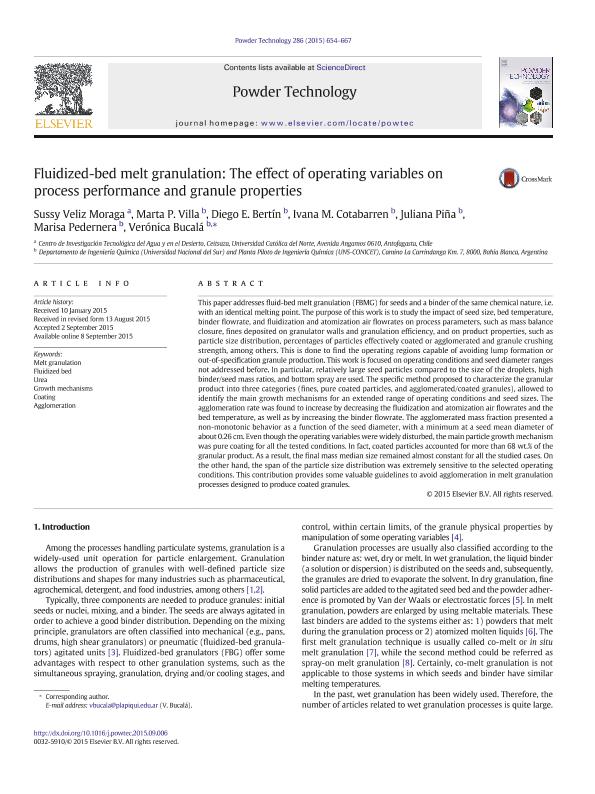Artículo
Fluidized-bed melt granulation: The effect of operating variables on process performance and granules properties
Veliz Moraga, Sussy; Villa, Marta Patricia ; Bertin, Diego Esteban
; Bertin, Diego Esteban ; Cotabarren, Ivana María
; Cotabarren, Ivana María ; Piña, Juliana
; Piña, Juliana ; Pedernera, Marisa Noemi
; Pedernera, Marisa Noemi ; Bucala, Veronica
; Bucala, Veronica
 ; Bertin, Diego Esteban
; Bertin, Diego Esteban ; Cotabarren, Ivana María
; Cotabarren, Ivana María ; Piña, Juliana
; Piña, Juliana ; Pedernera, Marisa Noemi
; Pedernera, Marisa Noemi ; Bucala, Veronica
; Bucala, Veronica
Fecha de publicación:
08/09/2015
Editorial:
Elsevier Science
Revista:
Powder Technology
ISSN:
0032-5910
Idioma:
Inglés
Tipo de recurso:
Artículo publicado
Clasificación temática:
Resumen
This paper addresses fluid-bed melt granulation (FBMG) for seeds and a binder of the same chemical nature, i.e. with an identical melting point. The purpose of this work is to study the impact of seed size, bed temperature, binder flowrate, and fluidization and atomization air flowrates on process parameters such as: mass balance closure; fines deposited on granulator walls and granulationefficiency; and on product properties such as: particle size distribution; percentages of particles effectively coated or agglomerated and granule crushing strength; among others. This is done to find the operating regions capable of avoiding lump formation or out-of-specification granule production.This work is focused on operating conditions and seed diameter ranges not addressed before. In particular, relatively large seed particles compared to the size of the droplets, high binder/seed mass ratios, and bottom spray are used. The specific method proposed to characterize the granular product into three categories (fines, pure coated particles, and agglomerated/coated granules), allowed to identify the main growth mechanisms for an extended range of operating conditions and seed sizes.The agglomeration rate was found to increase by decreasing the fluidization and atomization air flowrates and the bed temperature, as well as by increasing the binder flowrate. The agglomerated mass fraction presented a non-monotonic behavior as a function of the seed diameter, with a minimum at a seed mean diameter of about 0.26 cm. Even though the operating variables were widely disturbed, the main particle growth mechanism was pure coating for all the tested conditions. In fact, coated particles accounted for more than 68 wt% of the granular product. As a result, the final mass median size remained almost constant for all the studied cases. On the other hand, the span of the particle size distribution was extremely sensitive to the selected operating conditions. This contribution provides some valuable guidelines to avoid agglomeration in melt granulation processes designed to produce coated granules
Palabras clave:
Melt Granulation
,
Fluidized Bed
,
Urea
,
Growth Mechanisms
,
Coating
,
Agglomeration
Archivos asociados
Licencia
Identificadores
Colecciones
Articulos(PLAPIQUI)
Articulos de PLANTA PILOTO DE INGENIERIA QUIMICA (I)
Articulos de PLANTA PILOTO DE INGENIERIA QUIMICA (I)
Citación
Veliz Moraga, Sussy; Villa, Marta Patricia; Bertin, Diego Esteban; Cotabarren, Ivana María; Piña, Juliana; et al.; Fluidized-bed melt granulation: The effect of operating variables on process performance and granules properties; Elsevier Science; Powder Technology; 286; 8-9-2015; 654-667
Compartir
Altmétricas



